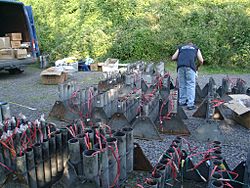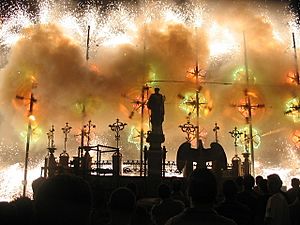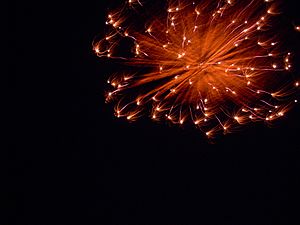Firework facts for kids
A firework is an explosive pyrotechnic device that is used mostly for entertainment. The most common use of a firework is as part of a fireworks display.
Fireworks (devices) are made to have these four effects: They make noise, light, smoke, and sometimes produce floating materials (confetti for example). They may be designed to burn with colored flames and sparks. Displays are common throughout the world and are a main point of many different cultural and religious festivals. Independence Day, New Year's Eve and Guy Fawkes Night are examples.
Some fireworks are ground-based, and others are shot into the air. Because they explode and can cause fires or burns, most countries have laws that only allow trained professionals to use display fireworks. Smaller, less explosive fireworks are available to regular, everyday people, but they are still dangerous and cause injuries each year.
Contents
History
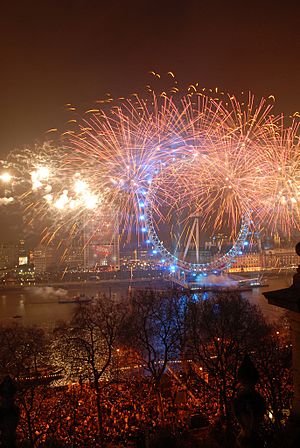
Fireworks dates back to the 7th century and originated in China. The Chinese developed many different kinds of fireworks with a variety of effects and color. The art and science of firework making developed into an independent profession. In China, pyrotechnicians were respected for their knowledge of complex techniques in mounting firework displays.
During the Song Dynasty (960-1279), many of the common people could purchase various kinds of fireworks from market vendors, and grand displays of fireworks were also known to be held. In 1110, a large fireworks display in a martial demonstration was held to entertain Emperor Huizong of Song (r. 1100-1125) and his court. A record from 1264 states that a rocket-propelled firework went off near the Empress Dowager Gong Sheng and startled her during a feast held in her honor by her son Emperor Lizong of Song (r. 1224–1264).
Rocket propulsion was common in warfare, as evidenced by the Huolongjing compiled by Liu Ji (1311–1375) and Jiao Yu (fl. c. 1350–1412). In 1240 the Arabs acquired knowledge of gunpowder and its uses from China. A Syrian named Hasan al-Rammah wrote of rockets, fireworks, and other incendiaries, using terms that suggested he derived his knowledge from Chinese sources, such as his references to fireworks as "Chinese flowers".
The New Year's Eve celebrations for 2014 in Dubai broke the world record for biggest fireworks display.
Types of effects
Cake
A cake is a cluster of individual tubes linked by fuse that fires a series of aerial effects. Tube diameters can range in size from ¼ inch to 4 inches, and a single cake can have over 1,000 shots. The variety of effects within individual cakes is often such that they defy descriptive titles and are instead given cryptic names such as "Bermuda Triangle", "Pyro Glyphics", "Waco Wakeup", and "Poisonous Spider", to name a few. Others are simply quantities of 2.5"-4" shells fused together in single-shot tubes.
Crossette
A shell containing several large stars that travel a short distance before breaking apart into smaller stars, creating a crisscrossing grid-like effect. Strictly speaking, a crossette star should split into 4 pieces which fly off symmetrically, making a cross. Once limited to silver or gold effects, colored crossettes such as red, green, or white are now very common.
Chrysanthemum
A spherical break of colored stars, similar to a peony, but with stars that leave a visible trail of sparks.
Dahlia
Essentially the same as a peony shell, but with fewer and larger stars. These stars travel a longer-than-usual distance from the shell break before burning out. For instance, if a 3" peony shell is made with a star size designed for a 6" shell, it is then considered a dahlia. Some dahlia shells are cylindrical rather than spherical to allow for larger stars.
Diadem
A type of Chrysanthemum or Peony, with a center cluster of non-moving stars, normally of a contrasting color or effect.
Fish
Inserts that propel themselves rapidly away from the shell burst, often looking like fish swimming away.
Horsetail
Named for the shape of its break, this shell features heavy long-burning tailed stars that only travel a short distance from the shell burst before free-falling to the ground. Also known as a waterfall shell. Sometimes there is a glittering through the "waterfall."
Kamuro
Kamuro is a Japanese word meaning "Boys Haircut" which is what this shell looks like when fully exploded in the air. A dense burst of glittering silver or gold stars which leave a heavy glitter trail and are very shiny in the night's sky.
Mine
A mine (aka. pot à feu) is a ground firework that expels stars and/or other garnitures into the sky. Shot from a mortar like a shell, a mine consists of a canister with the lift charge on the bottom with the effects placed on top. Mines can project small reports, serpents, small shells, as well as just stars. Although mines up to 12 inches in diameter appear on occasion, they are usually between 3 and 5 inches in diameter.
Multi-break shells
A large shell containing several smaller shells of various sizes and types. The initial burst scatters the shells across the sky before they explode. Also called a bouquet shell. When a shell contains smaller shells of the same size and type, the effect is usually referred to as "Thousands". Very large bouquet shells (up to 48 inches) are frequently used in Japan.
- Bangs and report
The bang is the most common effect in fireworks and sounds like a gunshot, technically called a report. - Crackle
The firework produces a crackling sound. - Hummers
Tiny tube fireworks that are ejected into the air spinning with such force that they shred their outer coating, in doing so they whizz and hum. - Whistle
High pitched often very loud screaming and screeching created by the resonance of gas. This is caused by a very fast strobing (on/off burning stage) of the fuel. The rapid bursts of gas from the fuel vibrate the air many hundreds of times per second causing the familiar whistling sound. It is not - as is commonly thought - made in the conventional way that musical instruments are using specific tube shapes or apertures. Common whistle fuels contain Benzoate or Salicylate compounds and a suitable oxidizer such as Potassium Perchlorate.
Palm
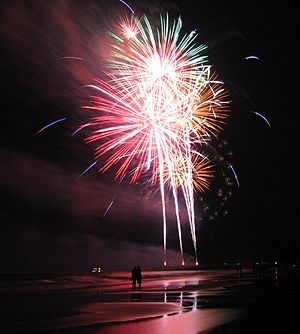
A shell containing a relatively few large comet stars arranged in such a way as to burst with large arms or tendrils, producing a palm tree-like effect. Proper palm shells feature a thick rising tail that displays as the shell ascends, thereby simulating the tree trunk to further enhance the "palm tree" effect. One might also see a burst of color inside the palm burst (given by a small insert shell) to simulate coconuts.
Peony
A spherical break of colored stars that burn without a tail effect. The peony is the most commonly seen shell type.
Ring
A shell with stars specially arranged so as to create a ring. Variations include smiley faces, hearts, and clovers.
Roman candle
A Roman candle is a long tube containing several large stars which fire at a regular interval. These are commonly arranged in fan shapes or crisscrossing shapes, at a closer proximity to the audience. Some larger Roman candles contain small shells (bombettes) rather than stars.
Salute
A shell intended to produce a loud report rather than a visual effect. Salute shells usually contain flash powder, producing a quick flash followed by a very loud report. Titanium may be added to the flash powder mix to produce a cloud of bright sparks around the flash. Salutes are commonly used in large quantities during finales to create intense noise and brightness. They are often cylindrical in shape to allow for a larger payload of flash powder, but ball shapes are common and cheaper as well. Salutes are also called Maroons.
Spider
A shell containing a fast burning tailed or charcoal star that is burst very hard so that the stars travel in a straight and flat trajectory before slightly falling and burning out. This appears in the sky as a series of radial lines much like the legs of a spider.
Time Rain
An effect created by large, slow-burning stars within a shell that leave a trail of large glittering sparks behind and make a sizzling noise. The "time" refers to the fact that these stars burn away gradually, as opposed to the standard brocade "rain" effect where a large amount of glitter material is released at once.
Willow
Similar to a chrysanthemum, but with long-burning silver or gold stars that produce a soft, dome-shaped weeping willow-like effect.
Images for kids
-
An illustration of a fireworks display from the 1628–1643 edition of the Ming Dynasty novel Jin Ping Mei
-
An etching of the Royal Fireworks display on the Thames, London, England, in 1749
-
A firework display by the British illustrator Ebenezer Landells, possibly the display given by Napoleon III on Queen Victoria's 1855 visit to Paris
-
Copper compounds glow green or blue-green in a flame
-
A firework rocket preparing its launch on the American Independence Day
-
Haze caused by smoke from fireworks, combined with smoke from wildfires few miles away from where the photo was taken
See also
 In Spanish: Fuegos artificiales para niños
In Spanish: Fuegos artificiales para niños



